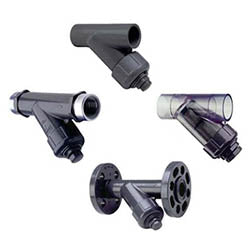Y-strainers look simple from the outside; just a funny shaped strainer doing its job. But that job is of the utmost importance, and for Y-strainers to perform their job properly, they must be clean. But how do you know when to clean something when you can’t see inside it? You can determine when to clean your Y-strainer by using pressure gauges to track differential pressure. If your differential pressure is between 5psi and 6psi, it’s time to clean the Y-strainer. Keep reading to learn how to measure differential pressure.
Tracking Differential Pressure
Differential Pressure is the difference in pressure between any two given points. Typically, on a line that requires a filter, you would have a tracking point upstream of the filter and one downstream of the filter. The purpose of placing pressure gauges both upstream and downstream of the filter is to help monitor the filter’s performance. When the differential pressure reaches a certain point, typically between 5psi and 6psi difference, you’ll know it’s time to clean your filter.
To properly track your differential pressure, you’ll first need to have a baseline pressure differential. When you first install your Y-strainer, you will need to find your differential pressure. This initial reading will become your baseline, or clean line, pressure differential. When your Y-strainer is first up and running you’ll want to take measurements frequently to help build up your baseline and to accurately gauge how the system is running.
Once you’ve gained baseline information on your system, you can start to spread out your measurements until you settle into a preventative maintenance routine that works for your system. While a differential pressure between 5psi and 6psi is a good rule of thumb for when to know your filter needs to be cleaned, you’ll want to work out your own preferences for when to clean your filter based on the overall performance of your system.
Speed Up the Cleaning Process
Once your differential pressure has reached your cleaning point, you’ll need to quickly clean your strainer and get your system back up and running. You’ll need to depressurize your system and have a few tools on hand such as a wrench and a wire brush. To learn more about how to clean your Y-strainer, read the post here.
To make the cleaning process quicker, you can use a blow-down connection on the Y-strainer. A valve is attached to the other end of the connection, and this valve is then used to open and close the connection, allowing the debris and filtered containments to be cleaned out without taking apart the Y-strainer or shutting off the system flow.
To ensure the strainer is cleaned at the proper time, we recommend having a few replacement screens on hand so there won’t be any unnecessary down times of your filtration system.
Why Y Strainers are a Good Investment
Y-strainers can be expensive, which is why you shouldn’t look at them as an expense but rather an investment. What they offer to your system—protection of the pump, turbines, or other important equipment—and their ease of use far outweighs any cost. As you look into building a new system or improving your current one, consider adding a Y-strainer to protect your line. Once you have your strainer installed, remember to keep a close eye on the changes to the pressure differential so you’ll know when to clean the strainer and keep your system running smoothly.

